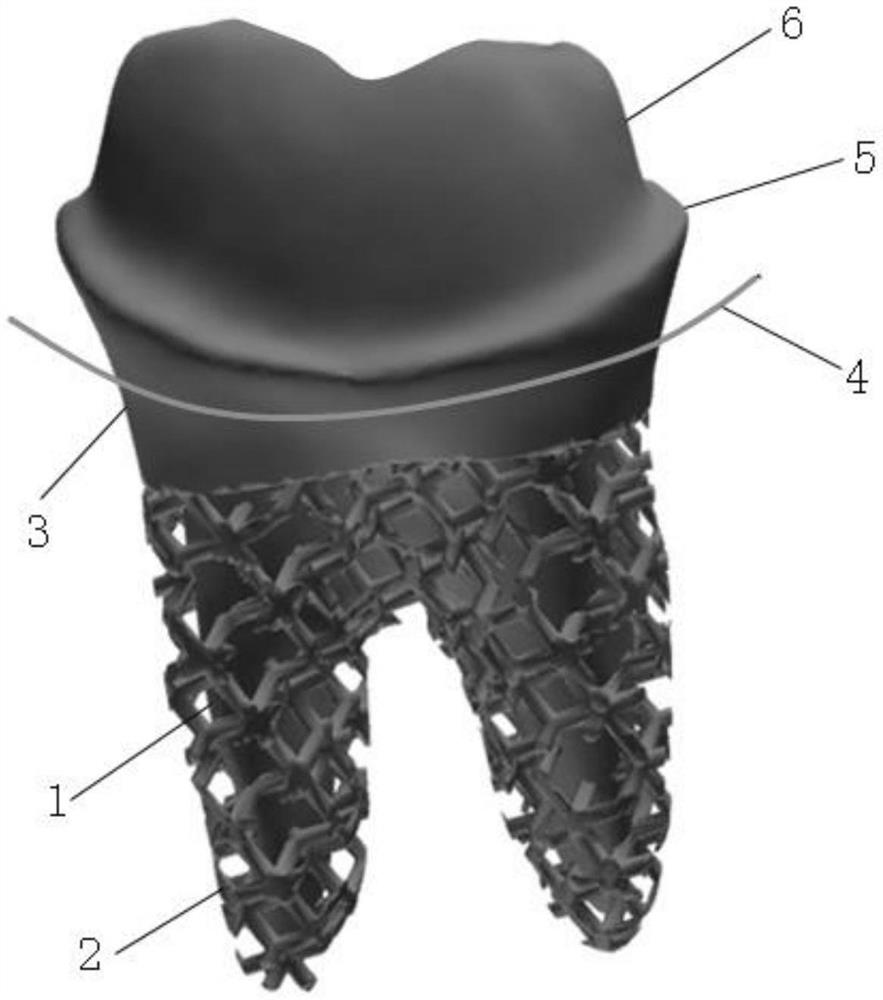A preparation method for 3D printing porous root-shaped dental implants
A 3D printing and dental implant technology, applied in dental implants, dentistry, dental prosthetics, etc., can solve the problems of difficulty in ensuring the microporous structure parameters of porous materials, and inability to accurately control the porous morphological structure, so as to shorten the implantation time. , to meet the accuracy and speed up the effect
- Summary
- Abstract
- Description
- Claims
- Application Information
AI Technical Summary
Problems solved by technology
Method used
Image
Examples
preparation example Construction
[0024] The present invention is a method for preparing a 3D printed porous root-shaped dental implant. The dental implant prepared by the method is as follows: figure 1 As shown, the method includes the following steps:
[0025] Step 1) Utilize CBCT to take the medical image data of the patient's maxillofacial region, and import the medical image data of the maxillofacial region into 3D image generation and editing processing software. The 3D image generation and editing processing software is Mimics software. Edit the imported medical image data of the maxillofacial region, delete images other than tooth root 1, keep only the medical image data of the affected tooth, and convert and export the STL format file of the affected tooth.
[0026] In step 1), edit the imported medical image data of the maxillofacial region according to the tissue density threshold, and delete images other than root 1. Specifically, adjust the tissue density threshold to a high tissue density value o...
Embodiment 1
[0037] This embodiment provides a method for preparing a 3D printed porous root-shaped dental implant, comprising the following steps:
[0038]Step 1) Utilize CBCT to take the medical image data of the patient's maxillofacial region, and import the medical image data of the maxillofacial region into Mimics software, adjust the threshold of tissue density to 1250Hu, and analyze the imported medical imaging data of the maxillofacial region according to the threshold of tissue density. Edit the image data, delete images other than tooth root 1, keep only the medical image data of the affected tooth, and convert and export the STL format file of the affected tooth.
[0039] Step 2) Import the STL format file of the affected tooth into Geomagic studio software to obtain the affected tooth model, delete the visible sharp corner features, undercuts and undulations by adjusting the grid of the affected tooth model, perform smoothing, and use the principle of quadrilateral point layout ...
Embodiment 2
[0044] This embodiment provides a method for preparing a 3D printed porous root-shaped dental implant, comprising the following steps:
[0045] Step 1) Utilize CBCT to take the medical image data of the patient's maxillofacial region, import the medical image data of the maxillofacial region into Mimics software, adjust the threshold of tissue density to 3810Hu, and analyze the imported medical imaging data of the maxillofacial region according to the threshold of tissue density. Edit the image data, edit the imported maxillofacial medical image data according to the tissue density threshold, delete the non-root 1 image, keep only the medical image data of the affected tooth, convert and export the STL format file of the affected tooth.
[0046] Step 2) Import the STL format file of the affected tooth into Geomagic studio software to obtain the affected tooth model, delete the visible sharp corner features, undercuts and undulations by adjusting the grid of the affected tooth m...
PUM
 Login to View More
Login to View More Abstract
Description
Claims
Application Information
 Login to View More
Login to View More - R&D
- Intellectual Property
- Life Sciences
- Materials
- Tech Scout
- Unparalleled Data Quality
- Higher Quality Content
- 60% Fewer Hallucinations
Browse by: Latest US Patents, China's latest patents, Technical Efficacy Thesaurus, Application Domain, Technology Topic, Popular Technical Reports.
© 2025 PatSnap. All rights reserved.Legal|Privacy policy|Modern Slavery Act Transparency Statement|Sitemap|About US| Contact US: help@patsnap.com

